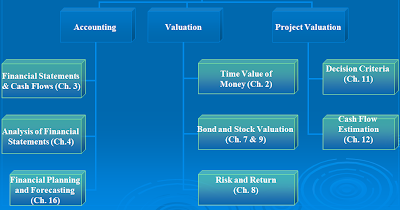Is also called statement of financial position. It is also a "Stock" measure statement
It categorizes a company's resources as:
- Assets
- Liabilities
- Owner's Equity
Balance Sheet Identity:
Total Assets= Total Liabilities + Shareholders' Equity
Balance Sheet Overview
Assets are categorized in order of liquidity-> how fast the specific assets can be converted into cash.
Cash-> most liquid asset (frequently represented by demand deposits. The Cash account often includes highly liquid marketable securities.
The Marketable Securities account refers to the investments of the company in either treasury bongs (issued by the government) or into stock of other organizations.
Net Accounts Receivable (Net A/R)-> occurs because the company sells products/services on credit. Allowance for doubtful accounts is available for Net A/R since customers often don't pay.
Net A/R = Gross A/R – allowance for doubtful accounts
Inventories accounts are found in Accounts Receivable (A/R) of the financial statement.
Gross fixed assets: original cost of assets
Fixed Assets: equipment, buildings, vehicles, computer, etc. Permanent nature; needed for business operations.
Reported book value= original historical cost - allowable depreciation.
The Accumulated Depreciation account refers to the depreciation accrued every year. (straight-line method and accelerated cost recovery)
Net fixed assets= gross fixed assets - accumulated depreciation
Total assets= Current assets + long-term assets
Assets(LHS of Balance Sheet) must be financed by a combination of liabilities and owner's equity (RHS of Balance Sheet)
Accrued Expenses-> Salaries
Notes Payable-> Usually sort term loans to banks-> generally refers to notes that are payable within the year.
Long-term debt refers to liabilities with maturities in excess of 1 year.
Total liabilities= current liabilities + L. T. debt
Preferred Stock (hybrid Security) Vs Common Stock-> typically preferred stockholders do not having voting rights. Usually when a company goes public for the first time and the entrepreneur has a vision for his company he issues preferred stock. Also on preferred stock a fixed amount of dividends is usually agreed.
Shareholders' equity= common stock at par+ additional paid-in capital+retained earnings
Shareholders' equity is also know as: Net Worth, Owner's Equity, book value of the firm's equity
Retained Earnings-> shows the accumulated profit a company has generated over the year.
Cumulative total of all net income reinvested into the company.
Annual addition to retained earnings = net income – dividends paid.
Dividend per share= Dividend paid/number of shares outstanding.









